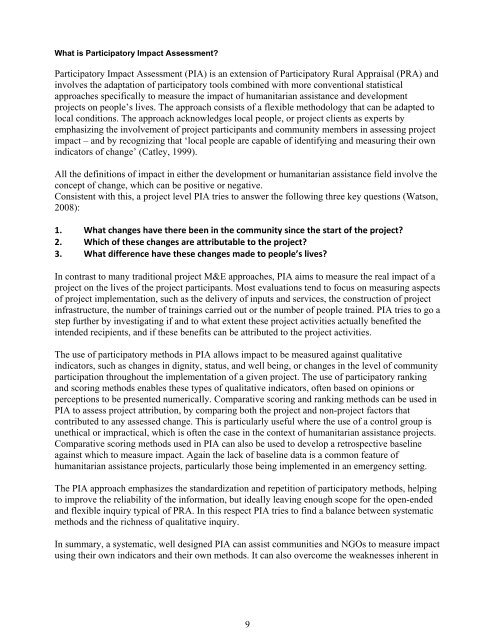Participatory Impact Assessment - Capacity4Dev
Participatory Impact Assessment - Capacity4Dev
Participatory Impact Assessment - Capacity4Dev
You also want an ePaper? Increase the reach of your titles
YUMPU automatically turns print PDFs into web optimized ePapers that Google loves.
What is <strong>Participatory</strong> <strong>Impact</strong> <strong>Assessment</strong>?<br />
<strong>Participatory</strong> <strong>Impact</strong> <strong>Assessment</strong> (PIA) is an extension of <strong>Participatory</strong> Rural Appraisal (PRA) and<br />
involves the adaptation of participatory tools combined with more conventional statistical<br />
approaches specifically to measure the impact of humanitarian assistance and development<br />
projects on people’s lives. The approach consists of a flexible methodology that can be adapted to<br />
local conditions. The approach acknowledges local people, or project clients as experts by<br />
emphasizing the involvement of project participants and community members in assessing project<br />
impact – and by recognizing that ‘local people are capable of identifying and measuring their own<br />
indicators of change’ (Catley, 1999).<br />
All the definitions of impact in either the development or humanitarian assistance field involve the<br />
concept of change, which can be positive or negative.<br />
Consistent with this, a project level PIA tries to answer the following three key questions (Watson,<br />
2008):<br />
1. Whatchangeshavetherebeeninthecommunitysincethestartoftheproject?<br />
2. Whichofthesechangesareattributabletotheproject?<br />
3. Whatdifferencehavethesechangesmadetopeople’slives?<br />
In contrast to many traditional project M&E approaches, PIA aims to measure the real impact of a<br />
project on the lives of the project participants. Most evaluations tend to focus on measuring aspects<br />
of project implementation, such as the delivery of inputs and services, the construction of project<br />
infrastructure, the number of trainings carried out or the number of people trained. PIA tries to go a<br />
step further by investigating if and to what extent these project activities actually benefited the<br />
intended recipients, and if these benefits can be attributed to the project activities.<br />
The use of participatory methods in PIA allows impact to be measured against qualitative<br />
indicators, such as changes in dignity, status, and well being, or changes in the level of community<br />
participation throughout the implementation of a given project. The use of participatory ranking<br />
and scoring methods enables these types of qualitative indicators, often based on opinions or<br />
perceptions to be presented numerically. Comparative scoring and ranking methods can be used in<br />
PIA to assess project attribution, by comparing both the project and non-project factors that<br />
contributed to any assessed change. This is particularly useful where the use of a control group is<br />
unethical or impractical, which is often the case in the context of humanitarian assistance projects.<br />
Comparative scoring methods used in PIA can also be used to develop a retrospective baseline<br />
against which to measure impact. Again the lack of baseline data is a common feature of<br />
humanitarian assistance projects, particularly those being implemented in an emergency setting.<br />
The PIA approach emphasizes the standardization and repetition of participatory methods, helping<br />
to improve the reliability of the information, but ideally leaving enough scope for the open-ended<br />
and flexible inquiry typical of PRA. In this respect PIA tries to find a balance between systematic<br />
methods and the richness of qualitative inquiry.<br />
In summary, a systematic, well designed PIA can assist communities and NGOs to measure impact<br />
using their own indicators and their own methods. It can also overcome the weaknesses inherent in<br />
9

















